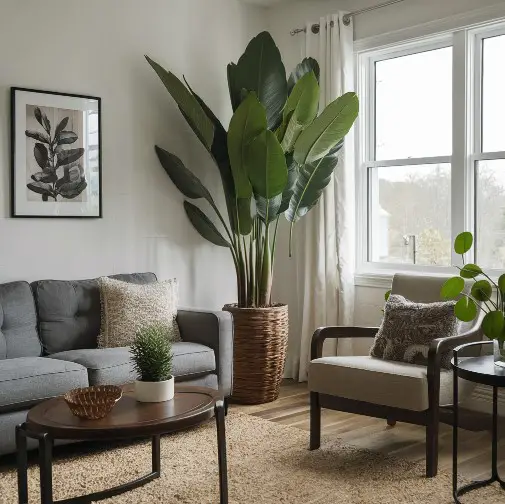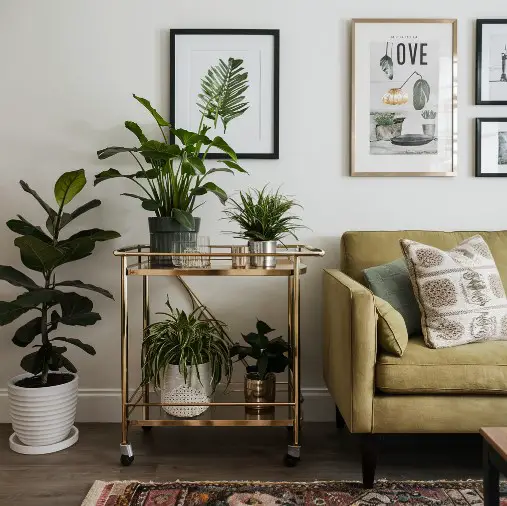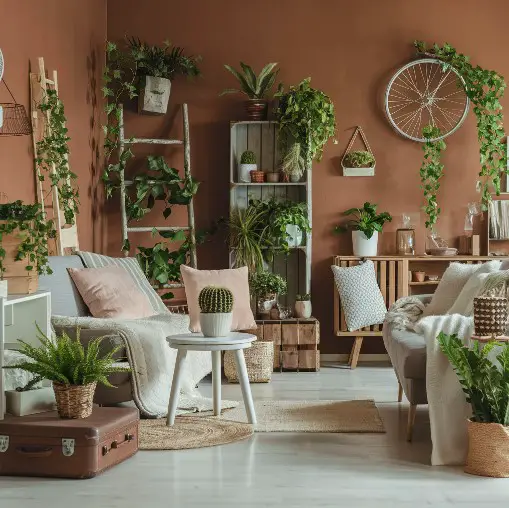Transform your living room with plants and experience a burst of freshness and tranquility like never before!
Incorporating greenery into your décor not only enhances the aesthetic appeal but also improves air quality and boosts mood.
Imagine vibrant houseplants adding a splash of nature’s beauty, creating a calming sanctuary right in your home.
Whether you’re a seasoned plant enthusiast or new to indoor gardening, our expert tips and plant recommendations will guide you in selecting the perfect varieties for your space.
Top 10 Creative Ways to Display Plants in Your Living Room
1. Create a Vertical Garden Wall

A vertical garden wall is a stunning way to showcase a variety of plants while saving floor space.
You can use wall-mounted planters or a trellis system to arrange your plants. This setup can accommodate a mix of trailing and upright plants, creating a lush, layered look.
Choose low-maintenance varieties like pothos or ferns to ensure easy care. Position your vertical garden in a well-lit area, or use grow lights if natural light is limited.
This display not only serves as a focal point but also improves air quality and adds a touch of nature indoors.
2. Utilize Hanging Planters

Hanging planters are an excellent solution for maximizing space and adding visual interest.
You can hang them from the ceiling, wall brackets, or even curtain rods. Consider using macramé hangers for a bohemian touch or sleek metal designs for a modern aesthetic.
Trailing plants like string of hearts or spider plants work beautifully in this setup, as they can cascade down, creating a stunning visual effect.
This method also keeps plants out of reach of pets or small children, making it a practical choice for families.
3. Group Plants on Shelves

Grouping plants together on shelves can create a mini indoor jungle effect. Choose shelves of varying heights to add dimension and interest.
Mix different plant types, sizes, and textures to create a dynamic display. For example, pair tall plants like snake plants with shorter ones like succulents.
This arrangement not only looks appealing but also allows plants to thrive in a micro-ecosystem, as they can share humidity and create a more humid environment.
Ensure that the plants you group together have similar light and water requirements for optimal growth.
4. Use Plant Stands for Height Variation

Plant stands are a fantastic way to introduce height variation in your plant display.
They come in various styles, from minimalist metal to rustic wood, allowing you to choose one that complements your decor.
By placing plants at different heights, you can create a layered look that draws the eye upward, making the room feel more spacious.
Consider using a tiered plant stand to showcase multiple plants in one spot, or mix and match different stands for a more eclectic feel.
5. Transform a Bookshelf into a Green Display

Bookshelves are often underutilized when it comes to displaying plants.
Instead of just books, incorporate plants among your literary collection. Use the top shelves for taller plants and the lower shelves for smaller varieties.
This not only adds life to your bookshelf but also softens the hard lines of the furniture.
Choose decorative pots that match your decor style, and consider adding some fairy lights for a whimsical touch. This approach creates a cozy reading nook that feels inviting and fresh.
6. Create a Focal Point with Large Plants

Consider using a large statement plant as a focal point in your living room.
Plants like fiddle leaf figs or rubber plants can command attention and add drama to the space. Position them in corners or near windows where they can receive ample light.
To enhance their impact, place them in decorative pots that complement your interior design.
Surrounding them with smaller plants can create a lush, layered effect, making the large plant stand out even more.
7. Incorporate Wall-Mounted Planters

Wall-mounted planters are an innovative way to display plants without taking up floor space.
These can be simple shelves or more elaborate wall art designs that incorporate planters. Choose a mix of small and medium-sized plants to create an interesting visual display.
This method is perfect for small living rooms or areas with limited space. Ensure the wall is in a well-lit area, or choose low-light plants like snake plants or ZZ plants for darker corners.
8. Use a Bar Cart for a Mobile Plant Display

A bar cart can be repurposed as a stylish plant display.
This mobile option allows you to rearrange plants easily and change the look of your living room whenever you want. Use the top shelf for a few larger plants and the lower shelves for smaller ones or decorative items.
This setup not only adds greenery but also serves as a functional piece of furniture. You can even style the cart with plant care essentials, making it a practical addition to your decor.
9. Create a Bathroom Oasis with Plants

While this may not be in your living room, consider adding plants to adjacent spaces like a bathroom.
Plants thrive in humid environments, making bathrooms an ideal location. Use floating shelves or small pots on the windowsill to display moisture-loving plants like ferns or peace lilies.
This not only enhances the bathroom’s ambiance but also purifies the air, creating a serene retreat.
When plants are placed thoughtfully in such spaces, they can elevate the overall aesthetic of your home.
10. Use Repurposed Items as Planters

Get creative by using repurposed items as unique planters. Old teacups, wooden crates, or even vintage suitcases can serve as charming plant containers.
This approach adds a personal touch to your decor and can be a great conversation starter. Ensure that any repurposed item has proper drainage to keep your plants healthy.
This method allows you to express your creativity while also incorporating greenery into your living space in a fun and unexpected way.
By implementing these creative ideas, you can seamlessly integrate plants into your living room, enhancing both the beauty and atmosphere of your home.
Whether you prefer a minimalist look or a lush jungle vibe, the right plant display can transform your space into a refreshing retreat.
Top 5 Benefits of Adding Plants to Your Living Room
- Improved Air Quality: Plants naturally filter pollutants and increase oxygen levels, creating a healthier living environment.
- Enhanced Mood: The presence of greenery can reduce stress and boost overall mood, making your living room a more relaxing space.
- Increased Aesthetic Appeal: Plants add a touch of nature and vibrancy, enhancing the visual appeal of your living room.
- Better Humidity Levels: Plants help maintain optimal humidity levels by releasing moisture into the air, improving comfort.
- Natural Sound Absorption: Plants can absorb sound, reducing noise levels and creating a quieter, more serene atmosphere.
What are the best indoor plants for a living room?
When selecting indoor plants for a living room, it’s essential to choose varieties that enhance both aesthetics and air quality while thriving in indoor conditions.
Consider these top picks for a vibrant and refreshing space:
- Snake Plant (Sansevieria) – Renowned for its striking, upright leaves, the Snake Plant is a low-maintenance choice that thrives in low light and improves air quality by filtering out toxins.
- ZZ Plant (Zamioculcas zamiifolia) – With its glossy, dark green leaves, the ZZ Plant is not only visually appealing but also highly resilient, making it perfect for low-light environments and infrequent watering.
- Pothos (Epipremnum aureum) – Known for its trailing vines and heart-shaped leaves, Pothos adds a touch of elegance and is incredibly easy to care for, thriving in various light conditions and requiring minimal upkeep.
- Fiddle Leaf Fig (Ficus lyrata) – For a dramatic impact, the Fiddle Leaf Fig offers large, bold leaves that create a statement piece in any living room, though it prefers bright, indirect light and regular watering.
- Peace Lily (Spathiphyllum) – Featuring lush green leaves and elegant white blooms, the Peace Lily not only adds beauty but also helps to purify the air, thriving in low to moderate light.
These plants not only enhance the aesthetic appeal of a living room but also contribute to a healthier indoor environment.
How often should I water indoor plants in the living room?
Watering indoor plants in the living room requires a balanced approach, as the needs of each plant can vary significantly.
Generally, a good rule of thumb is to check the soil moisture once a week. Most indoor plants thrive with a consistent watering schedule, allowing the top inch of soil to dry out between waterings.
However, factors such as the plant species, size, and the room’s lighting conditions can influence the ideal frequency.
For instance, succulents and cacti, which are accustomed to dry environments, need less frequent watering—often every two to three weeks.
On the other hand, tropical plants with higher humidity needs might require more regular watering. Observing the plant’s leaves can provide additional clues; if they appear droopy or yellowed, it might be time for a drink.
Conversely, if the soil remains damp for extended periods, it could indicate overwatering. Adjusting the watering frequency based on these signs ensures that indoor plants remain healthy and vibrant.
How do I prevent pests on indoor plants in the living room?
To keep pests at bay on indoor plants in the living room, it’s crucial to adopt a proactive approach. Start by ensuring proper plant care; healthy plants are less susceptible to infestations.
Water plants adequately but avoid overwatering, as damp soil can attract pests like fungus gnats. Regularly inspect plants for signs of trouble, such as discolored leaves or webbing, and act swiftly if any issues arise.
Consider using natural deterrents like neem oil or insecticidal soap, which are effective against common pests without harsh chemicals.
Introducing beneficial insects, like ladybugs or predatory mites, can also help manage pest populations naturally. Additionally, keep the living room clean and free of plant debris that can harbor pests.
Ensure that the plants have good air circulation by spacing them appropriately and avoiding overcrowding.
Regularly dusting the leaves can also prevent pest build-up. Finally, if an infestation does occur, isolate the affected plant to prevent the problem from spreading and treat it promptly with an appropriate pest control method.
Can indoor plants improve air quality in my living room?
ndoor plants are more than just decorative elements; they can genuinely enhance the air quality in a living room.
Through a process known as phytoremediation, plants absorb carbon dioxide and release oxygen, contributing to a fresher and more breathable atmosphere.
Some species, like the peace lily or spider plant, are particularly adept at removing common indoor pollutants such as formaldehyde, benzene, and trichloroethylene.
Additionally, indoor plants can help regulate humidity levels by releasing moisture through transpiration, which can mitigate the dryness that often accompanies artificial heating and cooling systems.
This added moisture can make the air feel more comfortable and reduce issues like dry skin or respiratory irritation.
Furthermore, the presence of greenery has been shown to have psychological benefits, such as reducing stress and improving overall well-being, which indirectly contributes to a healthier living environment.
Incorporating a variety of plants in your living room not only boosts air quality but also creates a serene and inviting space.
